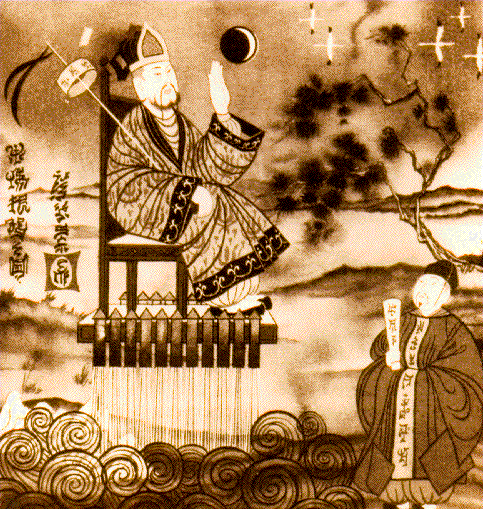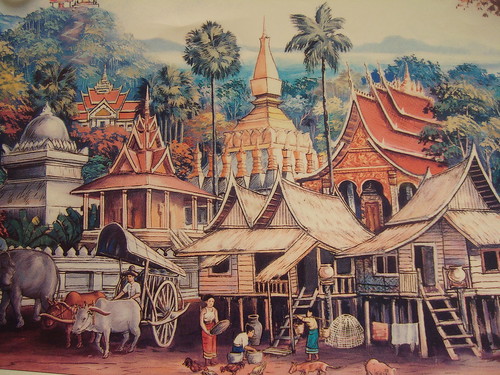
One account by Herbert Zim in 1945 claims that "Early in the sixteenth century, Wan decided to take advantage of China's advanced rocket and fireworks technology to launch himself into outer space. He supposedly had a chair built with forty-seven rockets attached. On the day of lift-off, Wan, splendidly attired, climbed into his rocket chair and forty seven servants lit the fuses and then hastily ran for cover. There was a huge explosion. When the smoke cleared, Wan and the chair were gone, and was said never to have been seen again."
Wan Hu was a minor official of the Ming Dynasty believed to have died around 1500 CE or what would have been the Lao year 2043. It would be interesting to examine how different history would have been if he had succeeded.
Depending on who you turn to in China, Wan Hu possibly managed to lift himself a foot using rockets. In most Chinese accounts though, he is considered just an unfortunate pioneer of space travel who burned to death or was blown to pieces because of the explosion caused by the rockets, and didn't really succeed in becoming the first astronaut in history.
Still, he gets credit for having the nerve to try.

Depending on who you turn to in China, Wan Hu possibly managed to lift himself a foot using rockets. In most Chinese accounts though, he is considered just an unfortunate pioneer of space travel who burned to death or was blown to pieces because of the explosion caused by the rockets, and didn't really succeed in becoming the first astronaut in history.
Still, he gets credit for having the nerve to try.

From a Lao point of view, if 1500 is accurate, In Lan Xang, this is the transition period between Somphou, who reigned between 1495-1500 and Visunarath who reigned between 1500-1520.
Lan Xang is approximately 150 years old, and 141 years away from first contact with the Dutch.
Lan Xang is approximately 150 years old, and 141 years away from first contact with the Dutch.
A few years earlier, Wan Hu would have been alive as Laasaenthai, the sixth son of King Sai Tia Kaphut, ruled. Crowned in 1491, Laasaenthai enjoyed peaceful relations with his neighbours in Annam and cultivated good relations with Ayudhya, "spending much of his time contemplating religious and legal matters, furthering the spread of Buddhism and building monuments." Sompou, who succeeds Laasaenthai, is his only son, according to historic records.
I imagine they all would have been very interested in the inquiries of Wan Hu. Even today, Lao celebrate our rocket festivals with great enthusiasm. What support might they have given him, what ventures might they have taken up on their own? And to be fair to Wan Hu's own experience, what misadventures?

For reference sake, this was also the era of the Hongzhi Emperor, Zhu Youcheng, who reigned between 1470-1505, and just a few years after Columbus reached the Americas in 1492, while Henry VII rules England. Ramathibodhi II rules Autthaya and Sukhothai. In Cambodia, they are ruled by Thommareachea I in the Charktomok era.
It will be 21 years before Magellan reaches the Philippines and 11 years before Malacca is conquered by Portugal, ending almost 100 years of the Malacca sultanate, which at the time was led by the sultan Mahmud Shah. Mahmud Shah is connected with the Malay legend of Puteri Gunung Ledang, which is about his failed courtship of a fairy princess.
In the century before, movable type printing has also been developed in Asia. Under the rule of Yongle Emperor, the Ming Dynasty territory reaches its pinnacle, the Forbidden City is built and Zhenghe has been commanded to explore the world overseas. Tamerlane established a major empire in the Middle East and Central Asia, in order to revive the Mongolian Empire. Also, the Inca Empire has risen to prominence in South America.

Possible steampunk or alternate history directions could be: What if Wan Hu didn't make it to the moon, but made it to Lan Xang. (Or made it to the moon and found a way back to earth, landing in Lan Xang?) Or perhaps, what happens if Wan Hu's experiment is still a failure but news of it inspires others to try, and perhaps someone in Lan Xang figures it out. Or thinks of something more interesting to do than try to go to the moon.
As the old saying goes, "Aim for the moon, hit the cow."
I imagine they all would have been very interested in the inquiries of Wan Hu. Even today, Lao celebrate our rocket festivals with great enthusiasm. What support might they have given him, what ventures might they have taken up on their own? And to be fair to Wan Hu's own experience, what misadventures?

For reference sake, this was also the era of the Hongzhi Emperor, Zhu Youcheng, who reigned between 1470-1505, and just a few years after Columbus reached the Americas in 1492, while Henry VII rules England. Ramathibodhi II rules Autthaya and Sukhothai. In Cambodia, they are ruled by Thommareachea I in the Charktomok era.
It will be 21 years before Magellan reaches the Philippines and 11 years before Malacca is conquered by Portugal, ending almost 100 years of the Malacca sultanate, which at the time was led by the sultan Mahmud Shah. Mahmud Shah is connected with the Malay legend of Puteri Gunung Ledang, which is about his failed courtship of a fairy princess.
In the century before, movable type printing has also been developed in Asia. Under the rule of Yongle Emperor, the Ming Dynasty territory reaches its pinnacle, the Forbidden City is built and Zhenghe has been commanded to explore the world overseas. Tamerlane established a major empire in the Middle East and Central Asia, in order to revive the Mongolian Empire. Also, the Inca Empire has risen to prominence in South America.

Possible steampunk or alternate history directions could be: What if Wan Hu didn't make it to the moon, but made it to Lan Xang. (Or made it to the moon and found a way back to earth, landing in Lan Xang?) Or perhaps, what happens if Wan Hu's experiment is still a failure but news of it inspires others to try, and perhaps someone in Lan Xang figures it out. Or thinks of something more interesting to do than try to go to the moon.
As the old saying goes, "Aim for the moon, hit the cow."
No comments:
Post a Comment